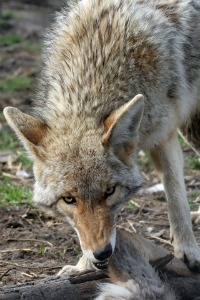
These events, rare as they are, are serious and warrant serious response.Ī coyote who has bitten a person will have to be specifically targeted and removed from the population. One involved a child in Southern California in the 1980s and the other a 19-year old woman in Nova Scotia in 2009. There have only been two recorded incidences in the United States and Canada of humans being killed by coyotes. Less often, people are bitten by cornered coyotes, or even more rarely, rabid coyotes. In many other instances, people were bitten while trying to rescue their free-roaming pet from a coyote attack. In many human attack incidents, it turns out that the offending coyote was being fed by people.

Often, coyote attacks are preventable by modifying human behavior and educating people about ways to prevent habituation. More people are killed by errant golf balls and flying champagne corks each year than are bitten by coyotes. Hazing entails using a variety of scare techniques to teach a coyote to regard people as threatening and stay away from them.ĭefense Whistles on Coyote attacks on peopleĬoyote attacks on people are very rare. When coyotes become habituated, hazing can reinstill the natural fear of humans. This generally occurs when a coyote has been fed (in the form of handouts, pet food left outside, or unsecured garbage).Ĭoyotes who come to depend on these sources of food may begin to approach humans looking for a handout and may begin to exhibit what’s perceived as “too tame” or aggressive behavior. HabituationĪ coyote who does not run away when encountering humans has, most likely, become accustomed or habituated to people. If the coyote is scared away by your presence, they are exhibiting natural behavior and this should not be cause for concern. Observing a coyote in this manner (even during the daytime) does not mean that the coyote is sick or aggressive.

You may catch a glimpse of a coyote, however, as they move from one part of their territory to another in search of prey (usually small mammals such as mice or voles). These animals are generally nocturnal and seldom seen. They communicate with a distinctive call, which at night often develops into a raucous canine chorus.An encounter with a coyote in the urban and suburban landscape is a rare event, even where coyotes are found in large numbers. The pups are able to hunt on their own by the following fall.Ĭoyotes are smaller than wolves and are sometimes called prairie wolves or brush wolves.

Both parents feed and protect their young and their territory. In spring, females den and give birth to litters of three to twelve pups. In the fall and winter, they form packs for more effective hunting.Ĭoyotes form strong family groups. BehaviorĬoyotes are formidable in the field where they enjoy keen vision and a strong sense of smell. Because they sometimes kill lambs, calves, or other livestock, as well as pets, many ranchers and farmers regard them as destructive pests.

They also happily dine on insects, snakes, fruit, grass, and carrion. They hunt rabbits, rodents, fish, frogs, and even deer. These adaptable animals will eat almost anything. Coyote populations are likely at an all-time high. They have even colonized cities like Los Angeles, and are now found over most of North America. These members of the dog family once lived primarily in open prairies and deserts, but now roam the continent's forests and mountains. Modern coyotes have displayed their cleverness by adapting to the changing American landscape. The coyote appears often in the tales and traditions of Native Americans-usually as a very savvy and clever beast.


 0 kommentar(er)
0 kommentar(er)
